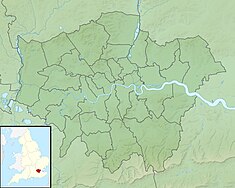Edmonton Incinerator
| Edmonton Incinerator | |
|---|---|

Edmonton Incinerator
|
|
| Official name | London EcoPark |
| Country | England |
| Location | Greater London |
| Coordinates | 51°36′57″N 0°02′29″W / 51.6158°N 0.0414°WCoordinates: 51°36′57″N 0°02′29″W / 51.6158°N 0.0414°W |
| Commission date | 1971 |
| Operator(s) | LondonWaste |
| Thermal power station | |
| Primary fuel | Waste |
| grid reference TQ357926 | |
Edmonton Incinerator (officially London EcoPark) is a municipal waste incinerator and waste-to-energy power station which burns London's waste to provide electricity for the National Grid. It is located on the River Lee Navigation and bordered by the North Circular Road, in Edmonton in the London Borough of Enfield.
The incinerator was commissioned (began operations) in 1971, by the Greater London Council. The building is of metal sheet clad construction with a 100 metres (330 ft) reinforced concrete chimney. It was described by Nikolaus Pevsner as being, "on the edge of the marshes, in a setting that enhances its impressive scale. Vast box-like forms clad in corrugated metal sheeting, pale grey and dark grey, approached by two big ramps on tapering piers. Huge cylindrical concrete chimney containing two flues". The incinerator is currently Britain's largest and it handles unrecycled waste from seven London Boroughs: Barnet, Camden, Enfield, Islington, Hackney, Haringey, and Waltham Forest. The waste is converted into electricity, bottom ash, air pollution control residue, and flue gases. 55 megawatts (MW) of electricity are generated, sufficient power to meet the needs of 24,000 households.
...
Wikipedia

